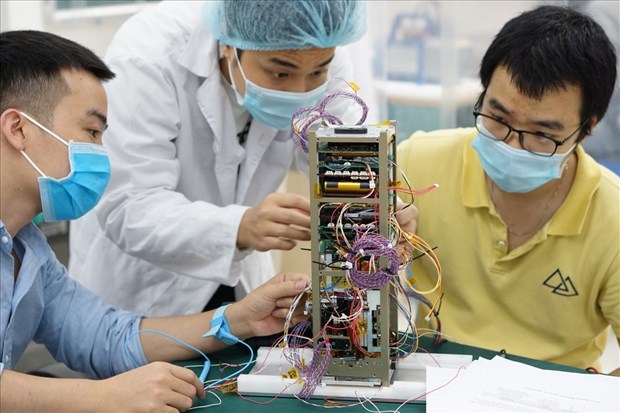
The launch of NanoDragon satellite is a chance for Vietnam to enrich experience, develop personnel, set up a network of suppliers and complete procedures for the development of other "Made-in-Vietnam" satellites in the future, said General Director of the Vietnam National Space Center (VNSC) Pham Anh Tuan.
The launch of NanoDragon satellite is a chance for Vietnam to enrich experience, develop personnel, set up a network of suppliers and complete procedures for the development of other “Made-in-Vietnam” satellites in the future, said General Director of the Vietnam National Space Center (VNSC) Pham Anh Tuan.
 |
| Scientists from the Vietnam National Space Centre manufacturing NanoDragon satellite. |
In an interview granted to the Vietnam News Agency (VNA) on the successful launch of the fifth Epsilon solid-fuel rocket carrying Vietnam’s NanoDragon into outer space at 7:55am (Hanoi time) on November 9, Tuan said that those involving in the manufacturing of NanoDragon have acquired a lot of experience after taking part in two previous projects of PicoDragon and MicroDragon. The research team had received assistance from many domestic agencies and organisations, he noted.
Tuan pointed out a number of difficulties facing Vietnam in this area, including poor infrastructure system and the incomplete system of research and development centres, land stations and satellite testing equipment, along with modest resources for satellite research and manufacturing.
Vietnam embarked on research on a number of aerospace science and technology areas in the 1980s, but those in mastering aerospace technologies, especially satellite technologies, have been conducted since 2006, he noted.
The sector is implementing a national key project to build a Vietnam Space Centre with major components such as building technical infrastructure system, training high-quality human resources and receiving the transfer of satellite technologies to create a firm foundation for realising the target of master technologies of designing and manufacturing nanosatellites, which included in the strategy on developing and applying aerospace sciences and technologies until 2030 that has been recently approved by the Prime Minister.
To date, Vietnam has owned six satellites that are operating in the orbit, including two telecommunications, one earth observation and three research satellites. Of those, three were developed by Vietnamese scientists.
NanoDragon satellite successfully separated from Japan’s fifth Epsilon solid-fuel rocket at 9:07 am (Hanoi time), flying in outer space by itself at a height of 560km.
(Source: VNA)





